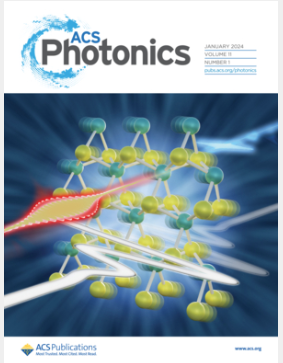N-Barrier-N Ga2O3 Photodetector Achieving Ultralow Equivalent Noise Power for Solar-Blind Detection
IF 6.5
1区 物理与天体物理
Q1 MATERIALS SCIENCE, MULTIDISCIPLINARY
引用次数: 0
Abstract
Solar-blind photodetectors operating in the deep ultraviolet (DUV) spectrum are critical for applications. However, the severe attenuation of DUV signals in the atmosphere demands photodetectors with ultralow noise and high sensitivity to resolve weak optical signals. Here, we report a breakthrough in β-Ga2O3-based n-Barrier-n (nBn) unipolar heterostructure photodetectors that synergistically address these challenges. By employing a β-Ga2O3/LaAlO3/Nb:SrTiO3 heterojunction fabricated via laser molecular beam epitaxy, we engineer a large conduction band offset and near-zero valence band offset, creating a unipolar electron transport channel that suppresses dark current to subpicoampere levels (<1 pA). The device exhibits exceptional performance metrics: a responsivity of 853.6 A/W, an external quantum efficiency of 4.2 × 105%, and a record-low noise-equivalent power (NEP) of 0.7 ± 0.1 fW/Hz1/2─surpassing state-of-the-art DUV detectors. These advancements are attributed to the high dielectric constant (∼24) and lattice compatibility of LaAlO3 with Nb:SrTiO3, which minimize interfacial defects and enhance carrier confinement. This work not only establishes a new paradigm for Ga2O3-based optoelectronics but also provides a universal design strategy for high-sensitivity, low-noise photodetectors in photon-starved environments, with transformative potential for deep-space communication and ultraviolet astronomy.

实现超低等效噪声功率用于太阳盲探测的n -势垒- n - Ga2O3光电探测器
在深紫外(DUV)光谱中工作的太阳盲光电探测器对应用至关重要。然而,大气中DUV信号的严重衰减要求具有超低噪声和高灵敏度的光电探测器来分辨弱光信号。在这里,我们报告了基于β- ga2o3的n-势垒-n (nBn)单极异质结构光电探测器的突破,该探测器协同解决了这些挑战。通过采用激光分子束外延制备的β-Ga2O3/LaAlO3/Nb:SrTiO3异质结,我们设计了一个大的导带偏移和近零的价带偏移,创建了一个单极电子传输通道,将暗电流抑制到亚皮安水平(<1 pA)。该器件表现出卓越的性能指标:响应率为853.6 a /W,外部量子效率为4.2 × 105%,创纪录的低噪声等效功率(NEP)为0.7±0.1 fW/Hz1/2,超过了最先进的DUV探测器。这些进步归功于LaAlO3与Nb:SrTiO3的高介电常数(~ 24)和晶格相容性,从而最大限度地减少了界面缺陷并增强了载流子约束。这项工作不仅建立了基于ga2o3的光电子学的新范式,而且为光子匮乏环境中的高灵敏度,低噪声光电探测器提供了一种通用设计策略,具有深空通信和紫外天文学的变革潜力。
本文章由计算机程序翻译,如有差异,请以英文原文为准。
求助全文
约1分钟内获得全文
求助全文
来源期刊

ACS Photonics
NANOSCIENCE & NANOTECHNOLOGY-MATERIALS SCIENCE, MULTIDISCIPLINARY
CiteScore
11.90
自引率
5.70%
发文量
438
审稿时长
2.3 months
期刊介绍:
Published as soon as accepted and summarized in monthly issues, ACS Photonics will publish Research Articles, Letters, Perspectives, and Reviews, to encompass the full scope of published research in this field.
 求助内容:
求助内容: 应助结果提醒方式:
应助结果提醒方式:


